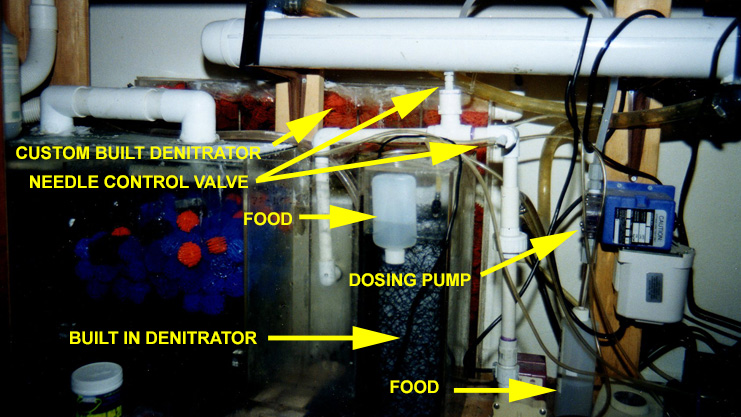The Denitrator
What is a Denitrator?
Why Do I Need One?
How Does it Work?

By Tony Griffitts
Published - 1991, Revised:
A denitrator is a biological filter that removes nitrate (NO3) from the aquarium. A denitrator filter uses anaerobic bacteria to break down nitrate into nitrogen gas (N2), which escapes into the atmosphere, resulting in nitrate-free effluent.
Nitrate is toxic to many marine invertebrates, even at low levels. The deaths of some of the more delicate marine fishes have also been linked to high nitrate levels in the aquarium.

A well-designed denitrator can maintain nitrate levels near 0 ppm. With low nitrate levels, you reduce the frequency and the volume of water you need to change annually.
A denitrator drastically reduces the time and money needed to maintain a reef tank. Also, you can stock the aquarium with many more fish and invertebrates than you can without a denitrator.
Water is sent through the denitrator at a slow flow rate. A needle valve is used to control the slow flow rate. The bacteria at the first part of the filter are aerobic (using oxygen). The aerobic bacteria use up all the free oxygen in the first stage of the filter. The second part of the filter is an anoxic (oxygen-depleted) environment, where anaerobic bacteria break the oxygen atoms off the nitrate to respire. At the end of the process, all the oxygen has been removed from the nitrate molecule, and the end byproduct is nitrogen gas (N2) which escapes into the atmosphere.
Anaerobic bacteria need a food source added to the filter in small amounts. Most hobbyists and researchers use ethanol [vodka] or sodium acetate (CH3COONa), also abbreviated NaOAc, as a food for denitrifying anaerobic bacteria. The concentration in a food solution can vary, and hobbyists must experiment to determine the proper concentration for their system.
When setting up the filter, run the aquarium water through it for about two weeks. This will give bacteria time to colonize the filter.
After two weeks, cut down the filter flow rate to about a drop or two a second. At this time, add about 5ml of the anaerobic bacteria food daily to the filter. A timed dosing pump that comes on four times daily is highly recommended for adding the food.
The denitrator takes about 4 to 6 weeks for the bacteria to colonize the filter in sufficient quantities for the filter to start reducing nitrate in the aquarium. Once daily, check the effluent water from the denitrator for nitrate and nitrite (NO2). If your tests indicate traceable amounts of nitrate and a noticeable amount of nitrite, you must slow the flow rate down. The presence of nitrite means that the anaerobic bacteria needs to be exposed longer, with only one oxygen atom removed from the nitrate.
The filter will be fully mature when it is 3 to 6 months old.
If reducing the flow rate does not help, increase the amount of food added to the filter. The increase in food may increase bacterial activity and nitrate reduction.
The filter will produce hydrogen sulfide if the flow rate is too slow and the bacteria are fed too much. The rotten egg smell can easily detect hydrogen sulfide. Increase the flow rate and test the effluent for nitrate and nitrite the next day.
Over time you will have to increase the flow rate as the filter matures and becomes more efficient. When your filter fully develops, your flow rate should be steady.
With experience, you can dial in the filter and know precisely how much food to feed and how fast the water should flow through the denitrator. A properly sized denitrator can handle all the system's excess nitrate, even in the most heavily stocked reef tanks.